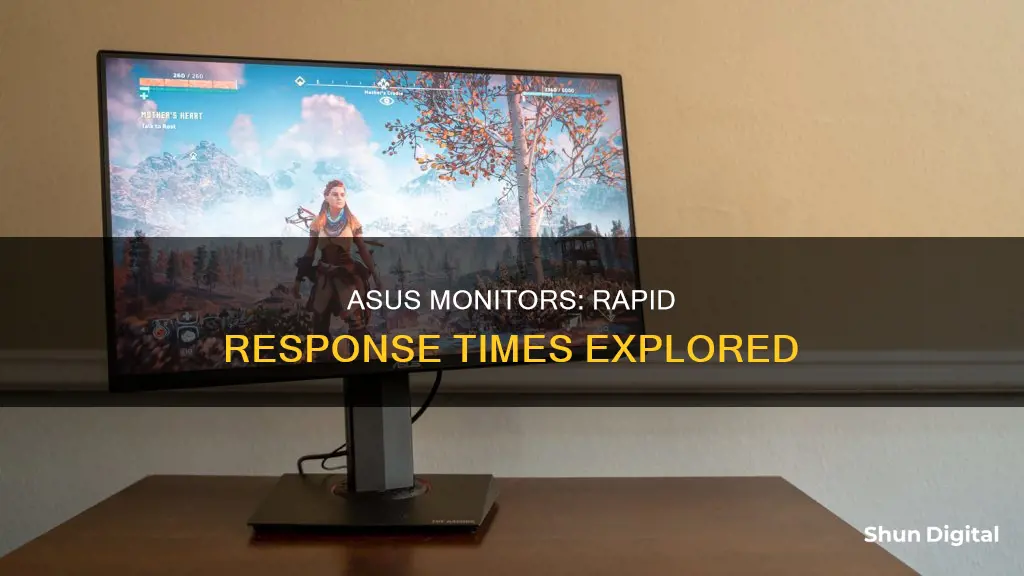
ASUS is a well-known manufacturer of gaming monitors, which are displays that can handle high-speed action without the blurring or ghosting effects that can occur on slower monitors. The speed of a monitor's response time is measured in milliseconds (ms), and the lower the number, the faster the response time. While a response time of 1-3ms is considered ideal for gaming, a monitor with a response time of 5ms will still be suitable for most users, as the lag will not be noticeable to many people. ASUS produces monitors with a range of response times, and it's important to choose the right one for your needs, as a faster response time will generally result in a better visual image.
| Characteristics | Values |
|---|---|
| Response time | 1-5ms for gaming monitors, 10ms average for black-to-white-to-black, under 10ms for LCD screens, 3-4ms for TN panels, 4-6ms for IPS panels, 8-12ms for VA panels |
| Refresh rate | Measured in hertz (Hz), the higher the better |
| Frame rate | Measured in frames per second (fps), the higher the better |
| Input lag | Not to be confused with response time, this is the delay between a keystroke/mouse click and the result on screen |
| Latency | The time taken for a request to be sent and responded to |
What You'll Learn

How does response time affect gaming?
Response time is a crucial factor for gamers when choosing a monitor. It refers to the speed at which a monitor's pixels can change colour, and is usually measured in milliseconds (ms). A faster response time results in a faster monitor.
For gamers, a low response time is ideal as it reduces the chance of "ghosting", blurring or colour issues. "Ghosting" is when you see the trail of an image across the screen, which can be distracting and disorienting, especially during competitive gaming. A high response time can also cause a noticeable lag in mouse movements.
While a low response time is desirable, it is not the only factor to consider. A balance of a low response time, high refresh rate, and low input lag is ideal. Input lag refers to the delay between a player's actions and what happens on the screen. A high input lag will result in a noticeable delay, which can negatively impact gaming performance, especially during competitive play.
A good gaming monitor will have a response time of 5ms or lower, with 1ms being ideal for competitive gaming. However, it is important to note that a low response time does not guarantee a great gaming experience if the input lag is too high. Therefore, when choosing a monitor, it is crucial to consider all three factors to ensure a smooth and responsive gaming experience.
ASUS offers a range of gaming monitors with low response times, such as the ROG Gaming Notebook, which has a response time of 5ms, and the LG 24GL600F, which has a 1ms response time.
Monitoring Internet Usage: Router Settings for Parents and Administrators
You may want to see also

How does response time differ from input lag?
Response time and input lag are two different things and are both important for a fluid gaming experience.
Response time refers to how fast a monitor's pixels can change colour from black to white or grey to grey. A quick pixel response time is needed to eliminate ghosting (trailing) behind fast-moving objects in fast-paced games. The response time is measured by how quickly the display can have a pixel change from fully active (white) to fully inactive (black). The faster this process, the lower the response time, which generally results in a better visual image.
Input lag, on the other hand, is the delay between the screen and your commands, such as a press on the keyboard or mouse. It is the time it takes for the monitor to react to an action you performed. Input lag is the time it takes for a monitor to receive a signal and then display the image on the screen.
While both are important, high input lag can make competitive gaming unbearable. A good monitor will have a balance of low response time and low input lag.
Monitoring Verizon Data Usage on Your Galaxy S7
You may want to see also

How does response time differ from refresh rate?
Response time and refresh rate are two important factors to consider when choosing a monitor, especially for gaming. While they are related, they refer to different things and have distinct impacts on your viewing experience.
Response Time
Response time refers to the speed at which a monitor's display can change the colour of a pixel. It is measured as the time it takes for a pixel to change from fully active (white) to fully inactive (black) and back again. This is usually measured in milliseconds (ms), with lower response times resulting in better visual quality, particularly for media with higher frame rates. Response times of 5ms or lower are generally considered good for gaming, with 1ms being ideal for professional gaming. Slower response times can lead to "ghosting", where you see the trail of an image that is no longer on the screen.
Refresh Rate
Refresh rate, on the other hand, refers to the number of times per second that a monitor can redraw the image it is displaying. It is measured in Hertz (Hz) and indicates how many times per second the monitor refreshes the image. A higher refresh rate means a smoother image and is particularly beneficial for gaming. While 60Hz is generally considered acceptable for casual gaming, professional gamers should opt for higher refresh rates, with 144Hz or 240Hz being preferable.
In summary, both response time and refresh rate are important specifications to consider when choosing a monitor, especially for gaming. Response time refers to the speed of changing individual pixels from one colour to another, while refresh rate refers to the number of times per second the entire image is redrawn. For the best gaming experience, you want a low response time and a high refresh rate.
Who Watches the Watchers: Internet Surveillance in the USA
You may want to see also

How does response time differ from frame rate?
When it comes to PC monitors, response time and refresh rate are two important factors that can impact your viewing experience. However, they are not the same thing and it is important to understand how they differ.
The response time of a monitor refers to how quickly the display can change a pixel from being fully active (white) to fully inactive (black). This is measured in milliseconds, so a 5-millisecond (5ms) response time means the monitor can go from white to black and back to white in 1/200th of a second. A lower response time generally results in a better visual image, with less noticeable ghosting. In gaming, a lower response time is usually preferred to ensure a sharper picture.
On the other hand, the refresh rate refers to how many times per second the panel can redraw the image. This is also measured in hertz (Hz), with a higher number being better. A 60Hz monitor will redraw the image 60 times per second, resulting in a 16-17ms delay between each frame. A 144Hz monitor, on the other hand, will redraw the image 144 times per second, reducing the delay to about 7ms. A higher refresh rate can provide a smoother viewing experience and is often preferred by gamers.
While both response time and refresh rate are important, they are not directly correlated. It is possible to have a monitor with a very low response time but a lower refresh rate, or vice versa. When choosing a monitor, it is important to consider both factors to ensure the best viewing experience. Additionally, input lag, which refers to how long it takes the monitor to react to an action performed, is another important factor to consider for a seamless gaming experience.
ASUS offers a range of monitors with varying response times and refresh rates, catering to different user needs and preferences. Some ASUS monitors, like the ROG Swift PG259QN, boast extremely low response times of 1ms, making them ideal for competitive gaming. Other models, like the ProArt Display PA278CV, offer a balance of a decent response time of 5ms and a high refresh rate of 75Hz, providing a smooth and responsive viewing experience.
Monitoring Gas Usage: Individual Apartment Solutions
You may want to see also

How does response time affect ghosting?
The response time of a monitor is the amount of time it takes for pixels to switch from one colour to another. A monitor with a slow response time can result in motion blur and smearing, which is known as ghosting. The faster the response time, the better the motion looks. This is particularly noticeable in games and media with higher frame rates.
A monitor with a slow response time can cause ghosting, which is when the pixels can't keep up with the movement on the screen, resulting in a trail of "ghost" images. This can be distracting for the viewer, especially for gamers who require quick reactions.
The response time of a monitor is measured by how quickly the display can have a pixel change from fully active (white) to fully inactive (black). The faster this process, the lower the response time, which generally results in a better visual image. A good gaming response time is typically considered to be anywhere from 1 to 3 ms, although some gamers find that a response time of 5 ms is still acceptable.
ASUS monitors, such as the ROG G750JZ, have been known to have response times of 8 ms, which some gamers may find too slow. However, it's important to note that the response time is just one factor affecting the overall performance of a monitor. Other factors include the refresh rate, input lag, and the type of panel used.
While a fast response time can reduce ghosting, it's possible to have a response time that is too quick, causing the pixels to overshoot their target colour. This can result in inverse ghosting, where a white trail is left behind fast-moving objects. Therefore, it's important to find a balance when adjusting the response time of a monitor to avoid both types of ghosting.
Monitoring Rust Game Servers: Tracking RAM Usage
You may want to see also
Frequently asked questions
The response time of a monitor is the time it takes for a pixel to change from one colour to another. This is usually measured in the time it takes to go from black to white and back to black, in milliseconds (ms).
A lower response time generally results in a better visual image, with less "ghosting" and clearer, faster motion. This is particularly noticeable in games and media with higher frame rates.
A good response time for gaming is generally considered to be 1-3ms. However, some gamers are happy with up to 5ms, as the lag is not very noticeable.
ASUS monitors with a 5ms response time are not considered the best for gaming, but they are still a good option as the lag is not very noticeable to many users. There are also other brands offering monitors with lower response times, such as LG and Dell.







